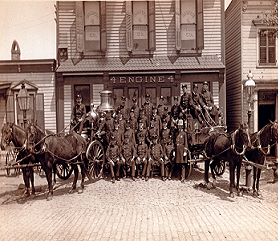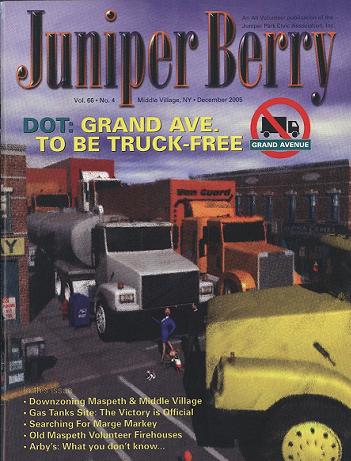The following story, which tells of the first fire fighting volunteers in Maspeth, was written by Barbara Stankowski. The book, “Maspeth – Our Town,” was given to Maspeth residents back in 1977 to commemorate the 30th Anniversary of the Maspeth Federal Savings & Loan Association. We think the story is interesting reading and we supplemented it with portions of an article by Dorothy Spears, Middle Village Historian and a frequent contributing writer to the Juniper Berry. We hope you enjoy the story about the very beginnings of the Town of Maspeth and its Volunteer Firefighters.
The Fire Dept. of Maspeth may be presumed to have been initiated at the same time as the new Village, in 1852. Earlier than that date, fires were most likely fought by the building owner and any neighbors close enough to assist with a bucket brigade. This arrangement was dependent upon the water supply at hand. If there was a well, someone would have to pump up the water or lower the bucket each time a bucket full of water was needed. Records often indicate that a barn belonging to such and such person was burned at a particular season. There is seldom any account of the fire and in Newtown Records, we do not find any mention of a person being injured fighting a fire, or losing his life through firefighting until the actual Volunteer Fire Department begins.
The earliest Fire Engine used locally was most likely the manual pumper which was a long wagon-like affair with handles running the entire length of the body on both sides. The handles were oaken bars which Firemen grasped, several men to each side of the engine, and pumped up and down with great force to drive the water through the hose. An engine of this type was heavy and was dragged to the fire scene either by horses or by the Firemen themselves, holding on to the sides as they ran along the streets.
The first fire company was organized in Newtown in September 1843 under the name of Wandowenock Hook and Ladder Company No. 1. A plot of land on which formerly stood a gun house belonging to the “Washington Blues,” a town military company, was given by the Town as a site for a fire house. Later it grew to 13 companies which fought fires and protected the life and property of the residents of Newtown, Elmhurst, Corona, Woodside, Glendale, Ridgewood, Maspeth, Middle Village and Winfield for more than 70 years. Wandowenock Fire Company in 1843 was No. 1. The organization of other companies followed. Company No. 2 was the Gooderson Engine Co. In Winfield in 1862 – the Woodside Hook & Ladder was No. 3 in 1878 – The Maspeth Engine Co. on Grand Avenue was No. 4 in 1888 – Maspeth Hook & Ladder on Perry Avenue was No. 5 in 1889 – Pioneer Hook & Ladder in Corona was No. 6 in 1890 – Fearless Fire Co. in Middle Village was No. 7 in 1890 – Louona Park Engine Company was No. 8 in Corona – Glendale Engine Co. at Cooper and Myrtle was No. 9 – Ivanhoe Park section of Glendale was No. 10 – Elmhurst Engine Co. was No. 11 in 1896 – Metropolitan Engine Co. at Forest and Metropolitan in Ridgewood (then called E.Williamsburgh) was No. 12 in 1903 – and the last company to join was Glendale Park Hook and Ladder in 1903 No. 13. It was located on the south side of Myrtle Ave. near what is now 89th Street.
About 1870, many Volunteer Fire Companies on Long Island were able to obtain steam boiler engines. The Engine carried a fire pan under the boiler which fired up the steam used to pressurize the water through the hose.
Obtaining this new, more efficient type of Fire Engine often caused the Fire Company to incorporate the word Steam in their name. In Maspeth, the No. 4 Engine Company changed their name to the Maspeth Steam Fire Engine Company No. 4.
The choice as to whether a company would be a steamer or a hook and ladder company depended on the type of buildings in the territory to be covered. For Instance, the Fearless Fire Company chose to be a hook and ladder company because of the many hotels along Metropolitan Avenue. John Niederstein’s hotel near Juniper Avenue (now 69th Street) was a large wooden structure with stables attached. Across the street was Sieb’s Hotel, an equally large two story wooden frame building. On the corner of Metropolitan Avenue and 70th Street was Albert Schumacher’s Hotel, another two story wood frame building. His hotel was smaller than the others because his stables were in a separate building in the rear. Albert Schumacher, besides operating his hotel, was the Justice of the Peace.
We believe the Fearless Company’s first fire house was on Juniper Avenue (69th Street) just north of Metropolitan Avenue. The building was one story and there were 36 men in the company. Frederick Repper was Foreman, John Fluhrer was First Assistant Foreman, John Niederstein, Jr. Second Assistant Foreman, Jovinianus Siebs was Secretary, Frederick Held, Financial Secretary, and Joseph Bermel,Treasurer.
When responding to an alarm with the Steam Fire Engine, the procedure was for the Firehorses to be hitched to the Engine and for the driver immediately to race to the fire scene. The other firefighters ran after the Engine as fast as they could on foot. It was necessary for Firemen to hold practice and drill sessions every week in order to keep fit. Belonging to the Company was a great distinction, whether a man belonged to the Engine Company, No. 4, or the Ladder Company, No. 5. Only the prominent men of the village were asked to join and only the most respected of these men could hope to become Foreman.
Engine Company No. 4 was housed first in a frame building on Grand Avenue which stood at the present location of Laurel Venetian Blinds, near 64th Street.
About 1895,another building was found for No. 4. It is presently the Frank Kowalinski Post on Maspeth Avenue,but it was abandoned when the modern firehouse of Maspeth was built by the City. Ladder Company No.5 was located in a frame building on Perry Avenue which is currently crossed by the Long Island Expressway. Both of the Fire Companies were proud bodies of brave and daring men. When a fire occurred in Maspeth, the Fire siren on top of the Alden Sampson Oil Cloth Factory would scream out its summons and fire fighters would race to the Firehouses to receive their direction. The firehorses were so accustomed to the signal that they often kicked down the doors of their stables, anxious to be off and running. The harness was suspended from the ceiling of the stable area so that it could be dropped into the waiting horses’ back to avoid wasting time. However, occasionally the horses got the bits in their teeth and bolted away with the Fire Engine, leaving the Firemen cursing and breathless after chasing them! When a sufficient number of men had reported to the fire house, the fire company proceeded to the fire.
Most Fire companies had a Dalmatian dog as a mascot and en route to the fire the barking dog ran along with the horses urging them to run faster. On the return trip back to the fire house, the dog having done its job, would sit proudly on the seat next to the driver. The Volunteers fought fires winter and summer. In winter the spray from the hoses froze on the Firemen’s faces and frosted their beards and mustaches.
Their feet suffered from the cold in the wet leather boots and it was not unusual for a Fireman to lose a few toes to frostbite. In the summer, the heavy clothing, the running, the heat of the fire, all caused the Volunteers to strain and curse as they battled a blaze. The work was exhausting, dangerous and daring but the fine old Volunteer Firemen were the most admirable brigade of their time.
When the City of New York embraced Queens County, in 1898, and Maspeth was absorbed into Greater New York, the Volunteers were notified that a paid City Fire Department would soon be taking over their duties. The volunteers were informed that they would be placed at the top of the list for the new paid positions if they wished to work as City employees and continue fighting fires. However, as is normally the case in all things concerning the City of New York, it was not until 1913 that the Volunteers continued their trade until the moment the City came in.
At the takeover, the City built a firehouse of their own in the Maspeth area, and this house was staffed with Engine Company 288 and Ladder Company 138. This Company continues to serve Maspeth today.




